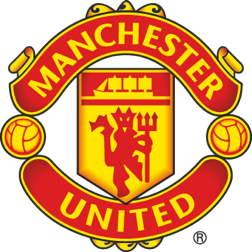The Academy: Landmark anniversaries in 22/23
A procession of landmarks approach this season, all of which are key to the remarkable work of Manchester United’s world-famous youth development.
90 YEARS: THE ‘A’ TEAM
Starting date: 27 August 1932 | Landmark date: 27 August 2022
In late March 1932, recent financial saviour James W Gibson spoke on “the advisability of running a colts team or nursery as from next season”. Diligent club secretary Walter Crickmer was duly tasked with its creation. Five months later, Crickmer had arranged entrance to the Manchester Amateur League, a contract with player Lal Hilditch to be manager and an agreement with Altrincham FC for use of their ground. Crickmer also welcomed to his Manchester home new first-team manager Scott Duncan, the Scottish team-builder charged by Gibson with developing youth into a successful side. Duncan hoped the ‘A’ Team would “develop youngsters’ talents and muscles and build up their frames”. Within a month of the new outfit’s first match – a 5-4 defeat to Ashfield on 27 August – two future first-teamers impressed sufficiently to earn professional contracts. George Vose and Jack Hall went on to make 282 senior appearances between them (1933-39), thus beginning an unerring tradition of graduation from United youth to United senior.
Studying mere numbers (19,312 total senior appearances by graduates at time of going to press, for your interest) is an injustice to the story of these nine decades. Manchester United’s commitment to youth development, from its 1932 inception, has been our bedrock and lifeblood. Success in M16 has followed a belief in the qualities of youth, the force that has catapulted United to our greatest moments, sustained and revitalised it in our worst.
On this anniversary, we celebrate the people whose passion and dedication created a globally renowned institution whose pupils’ names have touched the hearts of millions around the world. It is valuable, too, to celebrate graduates whose success did not come at Old Trafford, but elsewhere in football as a player, coach, physio or analyst, or in business or, in one case, as a priest.
“This place is about more than just football,” Cox says with pride. “It’s about young people learning, developing and going on to be successful.”
Starting date: 30 October 1937 | Landmark date: 30 October 2022
When Manchester United welcome West Ham to Old Trafford on Sunday 30 October 2022, if all goes to plan it will mark exactly 85 years since the start of an astonishing record.
By that date, United will have played 4,164 consecutive matches with an Academy graduate included in the matchday squad. This extraordinary statistic’s beginning is as far back as a late October day 22 months before the outset of World War Two. It has persisted through enormous changes to football, most notably the conversion of United from a club much-loved by Mancunians and a smattering of Britons elsewhere to an institution recognised worldwide and devoutly followed by hundreds of millions of supporters. This landmark is about numbers – barely believable numbers.
It was against another London club, Fulham, in 1937 when an otherwise unremarkable footballer by the name of Tom Manley started for United in a Division Two match. His appearance was not of note in the national newspapers, nor should it have been. He had made 160 of them already. The importance of this fixture is in retrospect only. Manley was United’s first U18 signing to graduate to the first team.
He was joined by Jackie Wassall, Stan Pearson and Johnny Carey. Seventy-eight successive matches with a graduate preceded World War Two, in the aftermath of which the world’s development accelerated at an unprecedented rate. Football went with it. But in Matt Busby’s team were Johns Aston, Anderson, Carey, Morris and Hanlon, all homegrown; Charlie Mitten, Stan Pearson and Joe Walton, too. Busby’s ‘Babes’ followed, then the boys who tragically stepped into their boots – Pearson, Brennan, Harrop and Carolan – then Best, and Kidd, McIlroy, Albiston, Whiteside, Hughes and Blackmore. Soon came Giggs, Neville, Beckham, Butt and Scholes, and Brown, O’Shea, Fletcher, Welbeck, Lingard and Pogba.
With Anthony Elanga, Scott McTominay and Marcus Rashford making a combined 96 appearances last season, and other graduates playing an additional 86 times, it is in little doubt that United will maintain this heritage up to October’s fixture with West Ham. The Academy still bursts at its seams with talented prospects and so the inheritance of this wonderful, organic legacy appears strong, too.
Starting date: 22 October 1952 | Landmark date: 22 October 2022
At the beginning of the 1952/53 season, Matt Busby told the United directors that he valued his young players at £100,000 in the transfer market. The first transfer of such value would not take place for another decade – when Denis Law joined United from Torino – but Busby’s young Reds, nurtured carefully by Jimmy Murphy, Bert Whalley and Joe Armstrong, justified his faith almost instantly.
The FA Youth Cup was launched in that season, an innovative attempt to add vigour and competitiveness to youth football. Barnsley manager Angus Seed had long floated such a concept as a passionate believer in young talent, but it was a different argument that convinced England’s biggest clubs. The record British transfer fee had seven times been broken in the seven years since war. Football League clubs desperately sought an alternative to huge spending, and building from the bottom was it. Six years and two days before the Munich Air Disaster, the competition that launched the careers of many of its victims was formed.
While many clubs scrambled to find local talent aged 15-18 to represent them, two teams in particular had no need to do so. Their commitment to youth pre-dated the Youth Cup’s inception by some way and Manchester United and Wolves would rightfully meet in the first final.
United in the Youth Cup: A miscellany
ArticleExplore the Reds' glorious FA Youth Cup history, from Duncan Edwards in 1952 to Kobbie Mainoo.
Wolves were a great side of the era with a flourishing youth set-up like United’s. Their manager Stan Cullis watched over some 50 junior players three nights a week at Molineux. They had six junior sides and a linked team in Glasgow. The local Birmingham Daily Gazette insisted it would be “surprising” if Wolves would not be the first holders of the Youth Cup.
United won the first leg 7-1, and finished 9-3 aggregate winners. Edwards “put United into a class of their own, his passing and anticipation the cornerstone of United’s success”. Eddie Lewis scored three over the two games, and Pegg one, again impressing Busby, who immediately took him to a first-team training camp in Scotland. Pegg would win another Youth Cup, in 1954, and Edwards a further one still in 1955. United’s coaches, players and supporters relished the chance to test youthful quality in knockout competition, with jeopardy and a touch of prestige. As our current holders can attest, little has changed in 70 years since.
Starting date: 3 September 1938 | Landmark date: 3 September 2023
“History was created in Manchester United football circles today,” wrote Alf Clarke in the Manchester Evening Chronicle. “This afternoon, there are no fewer than five United teams on duty. They are the senior side, Central League XI, ‘A’ team, MUJAC first team and MUJAC second XI... no club in the country is better served with junior players.”
The editor of United Review offered helpful context. “MUJAC! May I add a note about this mystic word: It stands for Manchester United Junior Athletic Club. Within a seven-mile radius of the United ground there are over 250 schoolboy soccer teams with upwards of 3,000 players. In order that promising players might not be wasted, MUJAC scheme was placed under the patronage of Manchester United Directors with a committee composed of teachers and other experienced friends. The club nights definitely encourage the lads to do well in their everyday occupations as well as in football. It is a splendid experiment.”
Six years after the creation of the ‘A’ Team, the same founding fathers of that successful enterprise formed MUJAC, revolutionary in its structure. Manchester’s most talented young footballers were brought together straight out of school, aged 15 or 16. Walter Crickmer had for a year worked with local teachers, PE instructors and school heads to establish an infrastructure that began with trials in August 1938. 15 young boys were chosen for MUJAC A and a further 15 for MUJAC B. One of those was 16-year-old John Aston, from East Manchester. Alongside Stan Pearson and Charlie Mitten, Aston’s MUJAC A romped to a debut title victory in the Chorlton Amateur League. The team scored 223 goals.
Post-war, other leading clubs leaned into such a system, but United’s headstart was enough. The Reds cantered to five FA Youth Cup victories after MUJAC’s original sons, Aston, Pearson and Mitten, won the 1948 FA Cup. League titles soon followed, and eventually the European Cup, too.




